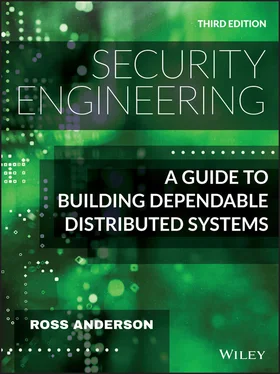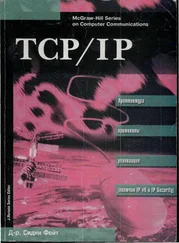1 Given , it is infeasible to compute (so it's not possible to compute either);
2 There is an encryption function which, applied to a message using the encryption key , will produce a ciphertext ; and
3 There is a decryption function which, applied to a ciphertext using the decryption key , will produce the original message .
For practical purposes, we will want the oracle to be replicated at both ends of the communications channel, and this means either using tamper-resistant hardware or (more commonly) implementing its functions using mathematics rather than metal.
In most real systems, the encryption is randomised, so that every time someone uses the same public key to encrypt the same message, the answer is different; this is necessary for semantic security, so that an opponent cannot check whether a guess of the plaintext of a given ciphertext is correct. There are even more demanding models than this, for example to analyse security in the case where the opponent can get ciphertexts of their choice decrypted, with the exception of the target ciphertext. But this will do for now.
The final cryptographic primitive we'll define here is the digital signature . The basic idea is that a signature on a message can be created by only one principal, but checked by anyone. It can thus perform the same function in the electronic world that ordinary signatures do in the world of paper. Applications include signing software updates, so that a PC can tell that an update to Windows was really produced by Microsoft rather than by a foreign intelligence agency.
Signature schemes, too, can be deterministic or randomised: in the first, computing a signature on a message will always give the same result and in the second, it will give a different result. (The latter is more like handwritten signatures; no two are ever alike but the bank has a means of deciding whether a given specimen is genuine or forged.) Also, signature schemes may or may not support message recovery . If they do, then given the signature, anyone can recover the message on which it was generated; if they don't, then the verifier needs to know or guess the message before they can perform the verification.
Formally, a signature scheme, like a public key encryption scheme, has a keypair generation function which given a random input  will return two keys,
will return two keys,  (the private signing key) and
(the private signing key) and  (the public signature verification key) with the properties that
(the public signature verification key) with the properties that
1 Given the public signature verification key , it is infeasible to compute the private signing key ;
2 There is a digital signature function which given a message M and a private signature key , will produce a signature ; and
3 There is a verification function which, given a signature and the public signature verification key , will output TRUE if the signature was computed correctly with and otherwise output FALSE.
Where we don't need message recovery, we can model a simple digital signature algorithm as a random function that reduces any input message to a one-way hash value of fixed length, followed by a special kind of block cipher in which the elf will perform the operation in one direction, known as signature , for only one principal. In the other direction, it will perform verification for anybody.
For this simple scheme, signature verification means that the elf (or the signature verification algorithm) only outputs TRUE or FALSE depending on whether the signature is good. But in a scheme with message recovery , anyone can input a signature and get back the message corresponding to it. In our elf model, this means that if the elf has seen the signature before, it will give the message corresponding to it on the scroll, otherwise it will give a random value (and record the input and the random output as a signature and message pair). This is sometimes desirable: when sending short messages over a low bandwidth channel, it can save space if only the signature has to be sent rather than the signature plus the message. An application that uses message recovery is machine-printed postage stamps, or indicia : the stamp consists of a 2-d barcode with a digital signature made by the postal meter and which contains information such as the value, the date and the sender's and recipient's post codes. We discuss this at the end of section 16.3.2.
In the general case we do not need message recovery; the message to be signed may be of arbitrary length, so we first pass it through a hash function and then sign the hash value. We need the hash function to be not just one-way, but also collision resistant.
5.4 Symmetric crypto algorithms
Now that we've tidied up the definitions, we'll look under the hood to see how they can be implemented in practice. While most explanations are geared towards graduate mathematics students, the presentation I'll give here is based on one I developed over the years with computer science undergraduates, to help the non-specialist grasp the essentials. In fact, even at the research level, most of cryptography is as much computer science as mathematics: modern attacks on ciphers are put together from guessing bits, searching for patterns, sorting possible results and so on, and require ingenuity and persistence rather than anything particularly highbrow.
Claude Shannon suggested in the 1940s that strong ciphers could be built by combining substitution with transposition repeatedly. For example, one might add some key material to a block of input text, and then shuffle subsets of the input, and continue in this way a number of times. He described the properties of a cipher as being confusion and diffusion – adding unknown key values will confuse an attacker about the value of a plaintext symbol, while diffusion means spreading the plaintext information through the ciphertext. Block ciphers need diffusion as well as confusion.
The earliest block ciphers were simple networks which combined substitution and permutation circuits, and so were called SP-networks [1011]. Figure 5.10shows an SP-network with sixteen inputs, which we can imagine as the bits of a sixteen-bit number, and two layers of four-bit invertible substitution boxes (or S-boxes ), each of which can be visualised as a lookup table containing some permutation of the numbers 0 to 15.
The point of this arrangement is that if we were to implement an arbitrary 16 bit to 16 bit function in digital logic, we would need  bits of memory – one lookup table of
bits of memory – one lookup table of  bits for each single output bit. That's hundreds of thousands of gates, while a four bit to four bit function takes only 4 x
bits for each single output bit. That's hundreds of thousands of gates, while a four bit to four bit function takes only 4 x  or 64 bits of memory. One might hope that with suitable choices of parameters, the function produced by iterating this simple structure would be indistinguishable from a random 16 bit to 16 bit function to an opponent who didn't know the value of the key. The key might consist of some choice of a number of four-bit S-boxes, or it might be added at each round to provide confusion and the resulting text fed through the S-boxes to provide diffusion.
or 64 bits of memory. One might hope that with suitable choices of parameters, the function produced by iterating this simple structure would be indistinguishable from a random 16 bit to 16 bit function to an opponent who didn't know the value of the key. The key might consist of some choice of a number of four-bit S-boxes, or it might be added at each round to provide confusion and the resulting text fed through the S-boxes to provide diffusion.
Читать дальше

 will return two keys,
will return two keys,  (the private signing key) and
(the private signing key) and  (the public signature verification key) with the properties that
(the public signature verification key) with the properties that bits of memory – one lookup table of
bits of memory – one lookup table of  bits for each single output bit. That's hundreds of thousands of gates, while a four bit to four bit function takes only 4 x
bits for each single output bit. That's hundreds of thousands of gates, while a four bit to four bit function takes only 4 x  or 64 bits of memory. One might hope that with suitable choices of parameters, the function produced by iterating this simple structure would be indistinguishable from a random 16 bit to 16 bit function to an opponent who didn't know the value of the key. The key might consist of some choice of a number of four-bit S-boxes, or it might be added at each round to provide confusion and the resulting text fed through the S-boxes to provide diffusion.
or 64 bits of memory. One might hope that with suitable choices of parameters, the function produced by iterating this simple structure would be indistinguishable from a random 16 bit to 16 bit function to an opponent who didn't know the value of the key. The key might consist of some choice of a number of four-bit S-boxes, or it might be added at each round to provide confusion and the resulting text fed through the S-boxes to provide diffusion.









